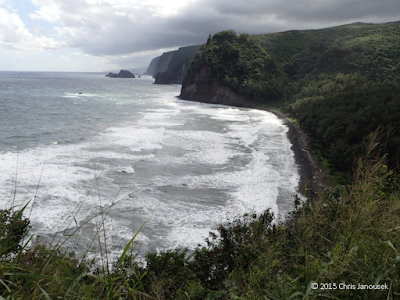 |
| Map of the Big Island with intertidal and subtidal sites I visited this fall. Map modified from this source. |
Sea urchins were one of the prominent groups of marine invertebrates
I encountered while exploring the intertidal and shallow subtidal of the Big Island Bishop Museum
1. The slate pencil urchin, Heterocentrotus mamillatus. This was the most striking of the
species I found on the Big
Island Big Island
 |
| Heterocentrotus mamillatus. Left: low intertidal urchin from Miloli'i. Right: subtidal animal at Old Kona Airport. |
2. Echinometra mathaei. This species was
the most abundant overall in my coastal visits, commonly occurring in both
intertidal pools and on subtidal reefs in high densities. The test diameter and
spine length are both on the order of a few cm. Body color varied from a pale
green to pink color. This species reminded me of Strongylocentrotus purpuratus, the common purple urchin of coastal California waters, in
terms of size and morphology, and by its tendency to hide in small holes in the
rocky substrate, perhaps sheltering there from predators.
 |
| Echinometra mathaei. Left: At Miloli'i; right: at Wai'opae. |
 |
| The collector urchin, at Puako Bay. |
3. The collector urchin, Tripneustes
gratilla. Typically a subtidal species, it is purple to black overall, but
often has at least some whitish and reddish spines. This species was common at Puako Bay Honaunau
Bay , Keauhou, and the Old Kona
Airport Indian
Oceans
4. The helmet urchin, Colobocentrotus
atratus. This is a common intertidal species, usually black in color. Most
of the spines on the body have been reduced to armor-like plates, while those
near the sides are elongated to form a skirt around the animal. This species
appears to favor more wave-swept coastlines and the overall shape probably
minimizes hydrologic drag on the body. This species is probably a major
intertidal herbivore, suggested by the barrens of pink corraline algae I often
found in the vicinity of the animals. I observed this species at Ka Lae, Miloli’i,
the Old Kona
Airport , and Waikui Beach
 |
| Colobocentrotus atratus. Both photos are from the intertidal at Keauhou, south of Kona. |
5. Echinothrix
calamaris, the banded urchin. This is a larger black urchin with menacing
spines, occurring as either an all-black morph, or with white and black-banded
spines. From my observations, the black morph was much more common on the Big Island Waikui Beach
and the shoreline near the Old
Kona Airport Honaunau
Bay
 |
| Two color morphs of Echinothrix calamaris. Left: subtidal at Honaunau Bay; right: subtidal at Waikui beach. |
 |
| Subtidal slate pencil urchins in coral at Waikui beach. |
















